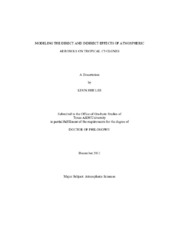| dc.description.abstract | The direct and indirect effects of aerosols on the hurricane ‘Katrina’ have been investigated using the WRF model with a two-moment bulk microphysical scheme and modified Goddard shortwave radiation scheme. Simulations of the hurricane ‘Katrina’ are conducted under the three aerosol scenarios: 1) the clean case with an aerosol number concentration of 200 cm-1, 2) the polluted case with a number concentration of 1000 cm-1, and 3) the aerosol radiative effects (AR) case with same aerosol concentration as polluted case but with a modified shortwave radiation scheme.
The polluted and AR cases have much larger amounts of cloud water and water vapor in troposphere, and the increased cloud water can freeze to produce ice water paths. A tropical cyclone in dirty and dusty air has active rainbands outside the eyewall due to aerosol indirect effects. The aerosol direct effect can lead to the suppressing of convection and weakening of updraft intensity by warming the troposphere and cooling the surface temperature. However, these thermal changes in atmosphere are concerned with the enhanced amounts of cloud hydrometeors and modification of downdraft and corresponding the low level winds in rainband regions. Thus, the AR case can produce the enhanced precipitation even in the weakest hurricane. When comparing the model performance between aerosol indirect and direct effect by ensemble experiments, the adjustment time of the circulation due to modification of the aerosol radiative forcing by aerosol layers may take a longer time than the hurricane lifetime, and the results from the simulated hurricane show that it is more sensitive to aerosol indirect effects which are related to the cloud microphysics process changes.
From this aerosol study, we can suggest that aerosols can influence the cloudiness, precipitation, and intensity of hurricanes significantly, and there may be different results in the meso-scale convective clouds cases. The hurricane system is a large and complex convective system with enormous heating energy and moistures. Moreover, relationships between various hydrometeors in hurricane systems are difficult to isolate and thus, it needs further study with more realistic cloud microphysical processes, aerosol distributions, and parameterizations. | en |


